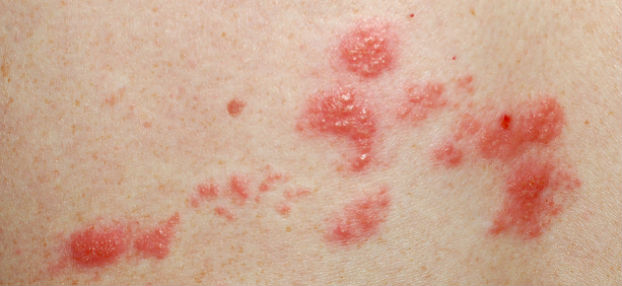Herpes zoster or shingles is characterized by a painful blistering rash limited on a stripe-like area of the skin. These blisters are small (usually up to a few millimeters) and evolve on a red, inflamed ground. This rash is mostly limited to one side of the body and appears as a single stripe. For example, shingles on a trunk wraps around the left or right side (not both sides!) of the torso. These characteristics are already sufficient for specialists to make the correct diagnosis. The rash is caused by a reactivation of the varicella zoster virus.
Shingles is an acute disease which can resolve within 4 weeks. However, complications are common which can lead even to persistent harm.
For arranging an appointment, please contact our office by phone +43 1 40114/5701, per E-Mail to ordination@hautarztokamoto.at or use the online-form.
Information about herpes zoster (shingles) by Dermatologist Prof. Dr. Okamoto in Vienna
Cause and symptoms of shingles

Shingles is caused by a reactivation of the varicella zoster virus, the same virus that causes chicken pox. Despite this, shingles is not the cause of a recent infection. The (initial) infection with the virus causes chicken pox, an itchy blistering rash that affects the entire surface (from the scalp to the toes). Chicken pox is very common during childhood and its course is usually uncomplicated in that age, except for some pockmarks. However, as for many other viral diseases during childhood, if infected as an adult, it can lead to severe complications. The virus is highly contagious and is spread by airborne infection (sneezing, coughing) even over long distances. A person having undergone chicken pox acquires immunity against the virus and therefore will normally not suffer from chicken pox another time but can develop shingles instead. After one has recovered from the initial infection, the virus remain in the nerves in a dormant state. Shingles is caused by a reactivation of this infection which occurred years or even decades ago. This reactivation can be triggered by numerous conditions such as severe, consuming diseases (cancer or severe infectious diseases), diseases suppressing the immune system (HIV), or treatment with immune suppressors in patients with organ transplantation. Other psychological conditions such as “stress” and even depressive states are claimed to trigger shingles.
Sometimes, shingles resembles simple herpes (herpes simplex) which can delay diagnosis. Both are characterized by grouped blisters but herpes simplex affects rather smaller, round areas and does not appear as a stripe. Herpes simplex also tends to relapse and reoccur on the same spot over and over again. The differentiation is crucial as shingles require a more intensive therapy and come with more serious complications: permanent so called neuropathic pain (postherpetic neuralgia), damage of the adjacent organs such as eyes and ears), paresis of the facial muscles (facial paresis) up to meningitis can be the consequences in untreated shingles. During the acute phase (with blisters), the lesion on the skin can be super infected by bacteria. General symptoms during herpes zoster include slight reduction of performance, fever, arthralgia, headache, dizziness, influenza-like conditions and malaise (general sick feeling).
Therapy
An intensive, systemic therapy that inhibit multiplication of the virus is required. For light to medium severe conditions, oral treatment is available. However, bed rest and therefore sick leave is required for both cure of the affected as well as preventing the spread of the virus (for those who have neither been vaccinated nor have sufficient antibodies due to lack of undergone chicken pox or other immune deficiency). Generally, shingles heals off after 3 to 4 weeks.
Please consider that both shingles as well as chicken pox are contagious!
Keep in mind that particularly individuals with immune deficiency or not vaccinated pregnant women (or those without antibodies against the virus, see above) should not come near someone with chicken pox or shingles. An infection with the varicella zoster virus before the 24th week of pregnancy as well as 5 days before until the day of birth could lead to serious and irreversible damage to the child.
Dermatologist Prof. Dr. Okamoto informs about shingles
Univ. Prof. Dr. Okamoto, specialist on skin diseases in Vienna, informs about shingles or herpes zoster as a medical expert for dermatology and venerology über Gürtelrose also on netdoktor.at.
Summary
Shingles (herpes zoster) is a serious disease which require systemic therapy. It is characterized by a painful blistering rash affecting one side of the body. A delayed diagnosis or missed treatment can lead to permanent damages. Early recognition and treatment is crucial to avoid long term complications.
Contact Prof. Dr. Okamoto
For appointments, please contact us by phone +43 1 40114/5701, 5702 or 5703, or via E-Mail at ordination@hautarztokamoto.at or contact form.
